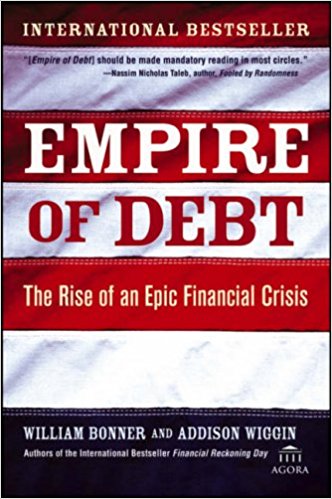Empire of Debt Summary
5 min read ⌚
 The Rise of an Epic Financial Crisis
The Rise of an Epic Financial Crisis
The twentieth century proved prosperous for the U.S. economy, which became the most significant and the fastest growing economy in the world. During his governing, Roosevelt flirted with the idea of territorial expansion, and by 1917, President Wilson was getting ready to enter the WWI.
Who Should Read “Empire of Debt”? And Why?
They chose to approach the problem by putting it in a historical and global context. They have filled these pages with historical data: the ancient Greeks, President Wilson’s adventures in Europe and Mexico, the extended Japanese deflation, etc.
The writing is fresh and cunning and does not let the reader sleep, which is rare, for a topic such as national debt. Hence, it is no wonder that this book reads like a historical novel, more than mere history.
It is probable that some readers will disagree with most of the authors’ opinions, but the perspective they offer and how they present it is too intriguing to disregard this book. We recommend “Empire of Debt” to investors, investment managers, and history lovers.
About William Bonner & Addison Wiggin
 William Bonner is the founder of the newsletter the Daily reckoning and Addison Wiggin is the editorial director and publisher.
William Bonner is the founder of the newsletter the Daily reckoning and Addison Wiggin is the editorial director and publisher.
Bonner is a co-author of Financial Reckoning Day and is a financial newsletter publisher. Wiggin authored The Demise of the Dollar…and Why It is Great for Your Investments.
“Empire of Debt Summary”
The U.S.’s army moved all over the world trying to bring democracy to other countries. Truman attacked Korea without waiting for a declaration of war, and Johnson got into Vietnam without securing a clear public mandate.
The nation commenced its imperialistic path and consequently needed to find means to invest in the army. To fund the WWI, for example, the U.S. used its newly legislated federal income tax. In the beginning, the tax rate was 1% on earnings higher than $3,000 and at most 7% on higher incomes.
Nevertheless, by the end of WWI the top rate escalated to 77% in 1918, and by the end of WWII, the bottom rate increased to 23%.
At the moment the U.S. budget planned for the military is larger than the sum of all other countries’ military budgets in the world. To be more precise, even if the budget got reduced by 75%, the U.S. army would still be the world’s most advanced force.
The same thing counts for households as well – many Americans are not aware that they would still have one of the world’s best living standards, even if they cut their household budgets in half. This is just what the U.S. Federal Reserve wants: people to continue spending.
In fact, it even encourages people to consume more and buy more stuff. These behaviors and actions have made America the cradle of consumerism.
Apart from everything else, Americans tend also to buy stocks, hoping that they will earn when they sell. However, they base their decisions on media propaganda, which holds no real content. They had forgotten the times when shares were more valuable when they paid a dividend.
Furthermore, they do not have as much knowledge as earlier investors, that got their experience from numerous ups and downs, have.
Another thing worth mentioning, when it comes to explaining how the U.S. got where they currently are, is the eradication of the gold standard.The gold standard had forced fiscal discipline on the world.
However, in 1971, President Nixon eradicated the standard, which meant that other countries could no longer reclaim their U.S. dollars for the gold that supported them. The moment the dollar’s value could not be connected to gold, deficits and inflation boomed.
What does that mean? Well, a 2005 dollar is worth five cents as opposed to a 1913 dollar.
Politicians rarely tell the truth. If they did, they would profess the fact that one out of four dollars the U.S. bureaucracy spends is borrowed. The current system works as follows: Asians manufacture products, Americans buy them, Asians lend back this money to the Americans.
The time has come when China is the one that keeps the U.S. economy from sinking. Government economists, however, seem unconcerned with the problem.
Key Lessons from “Empire of Debt”
1. A Debtor Nation
2. When the Bubble Burst
3. The “Essentialist” Philosophy
A Debtor Nation
As the U.S. emerged as a significant politically influential nation, it turned into a primary borrower. In 1952, 90% of the money the U.S. government obtained originated from U.S.-based investors. By 2005, however, the tides have turned: 45% of government bonds belonged to Non-U.S. investors.
Different countries claim a considerable amount of the U.S. debt: just China owns 25% of it. The U.S. has some level of control over loan fees, but China assumes a huge part. China is a world supplier and gets large sums paid in U.S. dollars. So, whenever U.S. consumers spend more, China benefits.
When the Bubble Bursts
Nowadays the stock market is creating smaller returns on average than it did in the late 90s, while the cost of living is 12% higher compared to previous years. It is no wonder that investors get more risk averse – they try to build portfolios that pay.
After the dot.com bubble, the housing bubble emerged next. Housing prices increased at the same pace as the money supply, and money supply has not noticed a faster expansion in the previous 30 years. At some point or another, housing prices will flatten out, and mortgage holders will understand that they are not wealthy.
Bubbles always burst. We all know what happened when the dot.com bubble broke. Now, you ask, what will happen when the property bubble breaks as well? Well, the nation could encounter the sort of extended deflation that has tormented Japan for as long as a decade.
In Japan, the housing prices plummeted in the last 13 years. If that were to happen to America, especially if it were paired with a stock market decline, a vast number of people would be pushed to bankruptcy. Then again, the Federal Reserve could inflate the dollar.
Japan, when they got into the crisis, had a high savings rate and did not lose its productive capability even amid the crisis. The U.S., on the other hand, is a country sunk in debt and has shut down a considerable amount of its manufacturing plants.
The “Essentialist” Philosophy
Speculation driven markets have been a trend for some time now. Speculation has increased the property prices unbelievably high and has twisted the meaning of investments. However, no man on Earth can predict the future.
Instead of trying to do the unachievable, become an essentialist. That is, focus on those things and decisions that you have to do to survive. Look back, study from all the previous generations of smart men and women. Don’t rely on information targeted at the masses, instead build on your own collected knowledge.
Crowds, in reality, have no analytical skills. So stay away from them. You may even want to bet against the prevailing investment trends. Just think of it as a horse race. The highest profit lays in betting on the winning horse, that previously had the lowest odds of winning.
Like this summary? We’d Like to invite you to download our free 12 min app, for more amazing summaries and audiobooks.
“Empire of Debt” Quotes
It is merely paper money without the paper-electronic registration of units of paper money. It is a mirage-a chimeric representation of something that doesn't exist anywhere. Share on X All empires must pass away. Share on X Public information is little more than the amplified sentiments of the crowd. Share on X Both parties recognized that Iraq was not a matter of national interest - it was a matter of imperial interest. Share on X People do not choose to have an empire, it chooses them. Share on XOur Critical Review
Do you think you know everything about the astounding U.S. national debt? Do you think you have heard every story there is to be told and seen every possible perspective? Well, think again. Authors Will Bonner and Addison Wiggin are presenting it as history.
Emir is the Head of Marketing at 12min. In his spare time, he loves to meditate and play soccer.


 The Rise of an Epic Financial Crisis
The Rise of an Epic Financial Crisis




